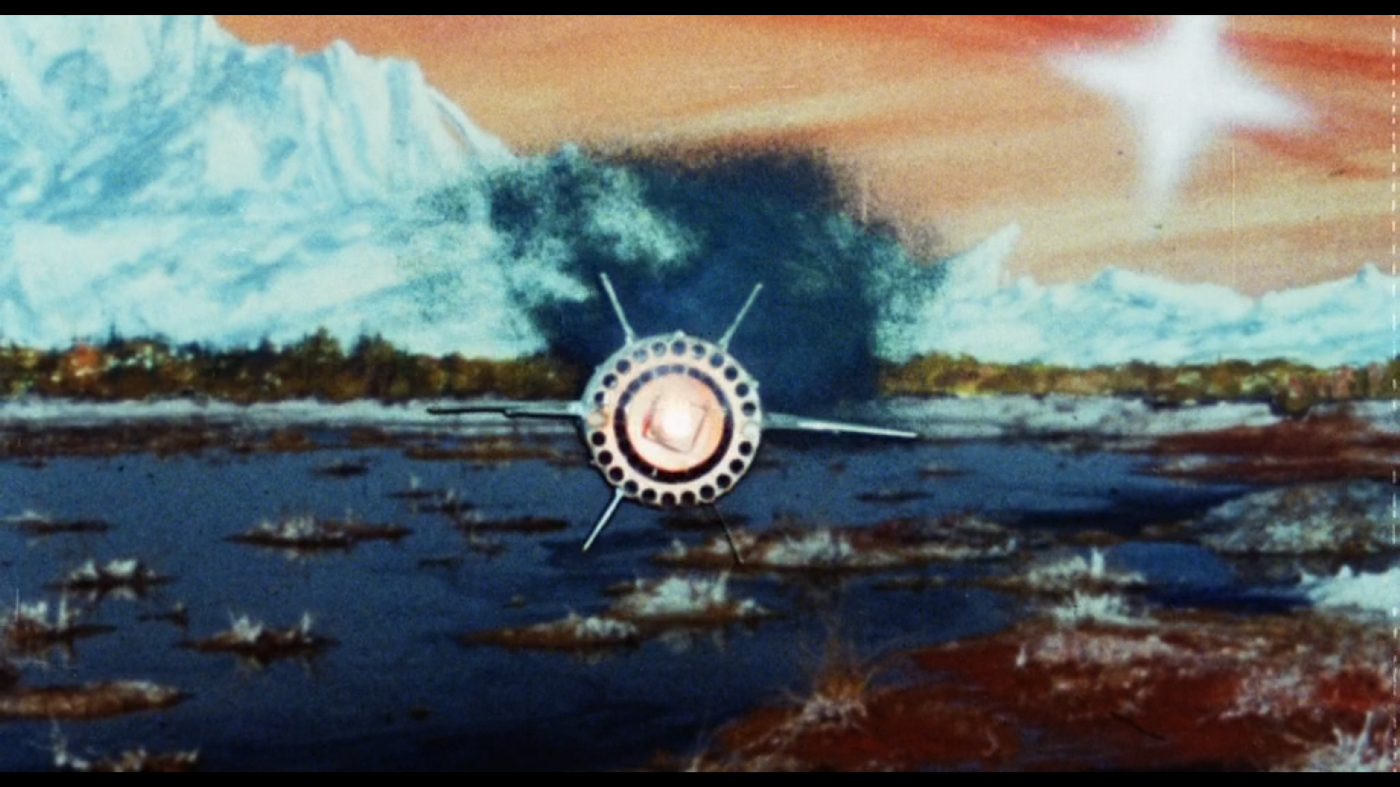
Polytheism is just demonstrably better than monotheism. The god of Abraham is such an authoritarian prick, but if you’re Hindu, and you’re not a fan of how strict Shiva is, you can switch to Vishnu, or if you’ve had enough of patriarchy, you can bow before Lakshmi, or Saraswati, or a dozen other female goddesses. You can even have your choice of colors. If you want a black god, you’ve got Kali, or for a blue one, there’s Krishna, or how about a god with the head of a monkey or an elephant? I mean, if you want to stick with your skinny dead guy nailed to a cross, you can, but you could have Shesha, the thousand-headed snake who floats on the cosmic ocean of eternity. A thousand heads are better than one.

In 1994, Shatilal Soni made a Hindu film called Jai Maa Vaishnodevi. It is a devotional film. Bollywood doesn’t make devotional films anymore, even though they are still popular when they get rebroadcast on TV. An Indian devotional film is the Hindu equivalent of The Greatest Story Ever Told (1965) or The Ten Commandments (1956).

Jai Maa Vaishnodevi is the story of the goddess Vaishnodevi. "Jai Maa Vaishnodevi" means "Praise Mother Vaishnodevi". As a devotional film, the central theme is, of course, devotion. The specifics of the plot are very similar to Bible stories. They involve desperate and humble people who are miraculously rewarded just in the nick of time by the deity they have shown devotion to.
On the surface, the devotional model seems simple. The idea is that maintaining an unwavering faith in God or the gods will always see you through. For example, in the film, Vaishnodevi tells a married couple to throw a grand feast and to invite the entire village to share in it. Everyone shows up, and at the very last second, the goddess appears and cooks everyone a pile of food. Actually, to my delight, all of the cooking was done in stop motion, with the knives miraculously chopping the spinach all by themselves, and the pots and pans dancing to a peppy little tune.
The idea of miraculously providing for the masses is, of course, in the Bible, too. There’s the fishes and loaves gambit, or the manna from Heaven in Exodus. The point is that God will always provide, even though 25,000 people die of starvation every day.
Telling the faithful that they must have faith in their deity and obey its commands has a deeper meaning in India, where there is the concept of the shishya (disciple) and the guru (teacher). It is through the complete trust in your teacher that you are able to set aside the ambitions of your ego and become a true student. A Buddhist monk once told me that any religion that decreases your ego is helpful. Devotion to your god or guru of choice is seen as a way of fostering selflessness, humility, and gratitude.
There is a second dynamic that Jai Maa Vaishnodevi shares with other religious stories. The story of miraculous recognition. You see it a lot in Greek mythology. It’s where a god disguises themselves as something humble, or even repulsive, and expects their followers to recognize them. Nothing like playing tricks on your acolytes.
The film is not just about Vaishnodevi’s devotees, it is also about Vaishnodevi herself. The movie begins with her creation story. She is created by three powerful goddesses: Saraswati (the goddess of knowledge and music), Lakshmi (The goddess of wealth), and Kali (the demon goddess of power). They imbue her with their combined power so she can fight and kill a demon. This is not an uncommon story in Hindu mythology. Sometimes, stories about different gods or goddesses are so similar, it’s hard to keep them straight. Then, there is the fact that gods can choose to appear in different forms, or even as each other. In this case, Vaishnodevi is actually an avatar of the goddess Durga.
Durga is a mysterious and sometimes controversial goddess. She has some scary-looking forms. She is the goddess of protection and motherhood, but also of destruction and war. She is the personification of Shakti, which is a powerful form of female energy.

In the movie, Durga, in the form of Vaishnodevi, is sent down to earth by Vishnu. When gods want to meddle in human affairs, they must be born into a human body and live out a human lifetime. It’s a form of self-sacrifice where a god leaves the perfection of Heaven to rub elbows with us as we sweat and toil here on Earth.

Vaishnodevi doesn’t want to go to Earth, but Vishnu insists. She must go walk among the humans to kill demons and show everyone the true path of goodness and purity. Her being sent to Earth and separated from the cosmic pantheon lends the story a sense of tragedy. She is a powerful goddess, but she is also a tool created by the gods to serve a purpose. Her devotion and obedience to her masters is an example for humanity to emulate.
She is seen as a mother goddess that nurtures the world. However, her being bound to the Earth makes her suspect to some Hindus. She is seen as too worldly, too material.
Most of the film is spent watching her fight the demon Bhairavanth in a proxy war. The human couple Sridhar and Sulochana are doing their best to be pious devotees to Vaishnodevi, but Bhairavanth tries to trip them up at every turn.

The arc of the story is pretty standard. Joseph Campbell would approve. Good triumphs over evil through pious patience and restraint, but fortunately, we do get a few action-packed fights along the way. Bhairavanth, the demon, has a brawl with the half-human, half-monkey hero Hanuman. Hanuman is Rama’s faithful servant from the epic poem The Ramayana, which runs concurrently alongside Vaishnodevi’s story. Every so often, the action and characters of The Ramayana spill over into the Vaishnodevi arc, like in Tom Stoppard’s Rosencrantz and Guildenstern Are Dead. When Bhairavanth and Hanuman face off, we are suddenly and unexpectedly thrust into a Power Rangers-style melee. Hanuman is armed with a giant golden mace (his weapon of choice), and Bhairavanth has a cardboard cutout of a saber. They hack at each other for a while, and each time their weapons make contact, an explosion of sparks bursts forth. Then, Bhairavanth begins chanting and grows into a 30-foot giant, but he is closely followed by Hanuman, who also switches to jumbo mode. Unfortunately, they never transform into mechanized Zords, but you can’t have everything.
The music in Jai Maa Vaishnodevi is good, but not great. There are plenty of breaks for heartfelt songs about faith and divinity. Unfortunately, in order to set the proper tone, the usual funky beats of Bollywood are minimized and replaced with the wall-of-sound style orchestra. The dancing is pretty lackluster as well, but overall, the musical numbers are still enjoyable.

There is a startling disconnect between mythic India and the reality of life in India. The female characters in these epic tales are so powerful and wise. They have dimensionality and a worldview that they espouse, but none of this is reflected in the patriarchal society of everyday India. Historically, feminists have pointed to the rise of monotheism as a major contributor to the establishment of patriarchal power. Goddesses like Athena, Freyja, Lakshmi, and Hathor were swept aside by the decidedly male Yahweh, who demanded complete and exclusive obedience to him alone, or you would suffer an eternity of torture in Hell.

Somehow, without the aid of a monotheistic tyrant, India managed to create a virulent patriarchy anyway. Today, 99% of abortions in India are of female fetuses. Where is Vaishnodevi when you need her?
At the end of the film, the whole thing turns into a promotional video for the tourism board of Jammu. A deep resonant voice with plenty of reverb takes the viewer on a tour of all the pilgrimage spots featured in the film. You can come and stand in all the places that are in the mythic story. All it’s missing is a package deal price and coupon at the end.




